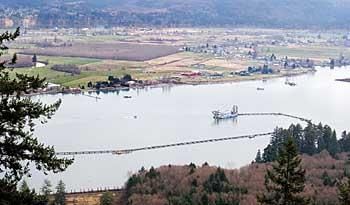forum
library
tutorial
contact

Study Highlights Investments
in Columbia River Ports
by Matthew Weaver
Capital Press, June 29, 2015
|
the film forum library tutorial contact |

|
Study Highlights Investments
by Matthew Weaver
|
 Businesses using the Columbia River have invested hundreds of millions of dollars since a 2010 project to deepen the 110-mile lower navigation channel from 40 feet to 43 feet, according to a study by the Pacific Northwest Waterways Association and the Port of Portland.
Businesses using the Columbia River have invested hundreds of millions of dollars since a 2010 project to deepen the 110-mile lower navigation channel from 40 feet to 43 feet, according to a study by the Pacific Northwest Waterways Association and the Port of Portland.
Public agencies and private companies have invested more than $1 billion in the lower Columbia River navigation channel and facilities since it was deepened five years ago, a new study says.
The Pacific Northwest Waterways Association and Port of Portland released a study outlining the $1.08 billion in public and private investments. The U.S. Army Corps of Engineers spent $180 million to deepen the 110-mile navigation channel from 40 to 43 feet. The dredging was finished in 2010.
The study also documented investments in grain export facilities, mineral bulk export facilities and rail and road infrastructure following completion of the channel deepening project.
"All of these projects were due, some totally, some in part, to the channel deepening project," said Kristin Meira of the waterways association. "It made our river system more efficient and a better place to do business."
The $230 million Export Grain Terminal at Longview, Wash., was the first new grain export facility in North America in roughly 25 years, she said.
Other projects cited in the study include:
Roughly 77 percent of the Portland port's current business is related to movement of agricultural and mineral bulks, said Curtis Robinhold, deputy executive director of the port, in a press release.
"The deepening of the channel has led to an increase in volumes of bulks at our facilities since ships can travel more fully loaded," Robinhold stated.
Meira said the study shows why the river is important to the region and the nation. Maintenance and targeted investment are crucial to ensure a competitive transportation system, she said.
The system is slated for a 14-week closure beginning in December 2016 for lock maintenance. Navigation channels require adequate financial support from the federal government to be maintained, Meira said.
"This is not a river system that's simply holding in place," she said. "Folks are making hundreds of millions of dollars of investments in their facilities. They are banking on the future of the Columbia-Snake river system."
Related Pages:
Impacts of Channel Deepening on the Columbia River by ECONorthwest, June 2015
learn more on topics covered in the film
see the video
read the script
learn the songs
discussion forum
